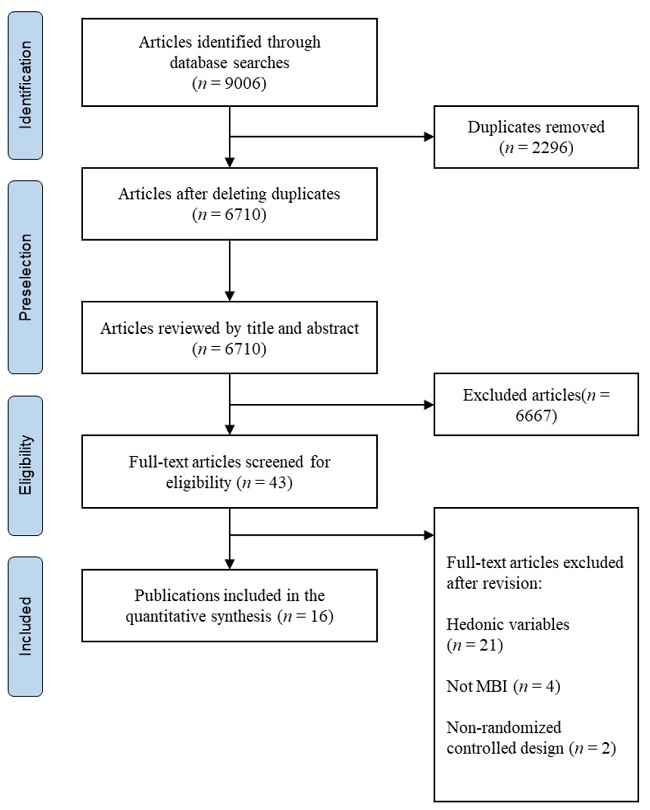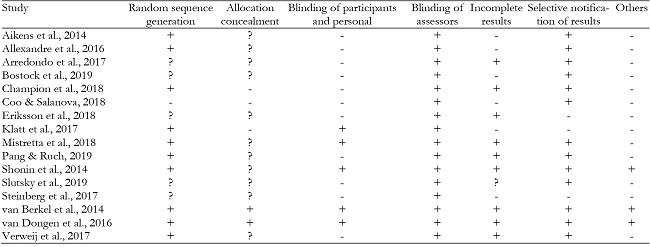Introduction
Eudaimonic well-being
Science, traditionally influenced by Hellenistic philosophy, has distinguished two approaches in the study of well-being (Dahl & Davidson, 2019). On the one hand, the existence of hedonic well-being (also called subjective well-being or, just, happiness) has been described, based on the thinking of Aristippus, a Cyrenaic philosopher who assumed the existence of a natural tendency of the organism to obtain rewards and avoid punishments. Happiness would be, then, the opposite of misery and the study of it should focus on the causes that make experience and life pleasant or unpleasant. However, this conceptualization could be considered limited, superficial and amoral, because a state of well-being implies something deeper than simply feeling good (Vittersø, 2016). The second perspective is the eudaimonic way, exposed on Aristotle's work “Nicomachean Ethics”, and generally referred to in the scientific literature as "psychological well-being" (Ryff, 2018). Eudaimonia implies a state of well-being based on the meaning of life and self-realization, as a consequence of an integral and virtuous functioning of the person. This implies having respect for ourselves and others, as well as developing our potential, always rediscovering new meaning and purpose in our individual and collective existence. However, there are unifying approaches between hedonia and eudaimonia, understanding them as complementary and not as independent constructs. This is the case of the PERMA model (Seligman, 2012), an integrative approach which considers that well-being would be composed of: (a) presence of positive emotions, (b) dedication, (c) meaning, (d) achievement, and (e) positive relationships.
Focusing on the study of eudaimonia, psychological well-being is one of the most prominent models (Ryff & Keyes, 1995; Ryff & Singer, 2008; Ryff, 2018). According to this model, the optimal human functioning would include the following six core dimensions (Ryff, 2018):
Autonomy: The independence, self-regulation and self-determination of the person. This leads to autonomous functioning that is resistant to the pressure of the culture, with the locus of control located in the person, who does not require the approval of others.
Environmental Mastery: The ability to choose or create a beneficial context for psychological needs, essential for mental health.
Personal Growth: It refers to self-realization and the scope of personal potential through constant evolution over time.
Positive relations with others: The ability to love and be loved by other people, deeply identifying with them, as well as having strong feelings of empathy and affection. Likewise, it implies the establishment of close and warm friendship relationships.
Purpose in life: A clear understanding that life has a meaning, which brings direction and intentionality to existence.
Self-acceptance: Having a positive view of oneself, becoming aware of and accepting both the lights and the shadows of the self.
Mindfulness
Mindfulness (Anglo-Saxon translation of the Pali word sati), is a psychological process whose definition and use in the Western context is controversial (Purser & Milillo, 2014; Samuel, 2014; Joiner, 2017; Van Dam et al., 2018). Although science has defined it in various ways, a proposal closes to its original meaning in the Sattipathana Sutta (the Discourse on the Foundations of Mindfulness) is offered by Segovia (2017), who describes it as an intentional way of paying attention to the phenomena that appear in consciousness, without emotional or cognitive distortion, and diligently remembering to retrieve it whenever there is distraction.
Mindfulness training through meditation has become a common practice in the clinical setting and the general public. Certainly, its practice has become popular thanks to the wide spread of mindfulness-based interventions (MBIs), of which the Mindfulness-based Stress Reduction program (MBSR) (Kabat-Zinn, 1982; 2013) is the reference standard. (Crane et al., 2017). The objective of this brief intervention is to change the way people relate to stressors, doing so from awareness and acceptance, in order to reduce the harmful effects of the stress psychophysiological reaction (Santorelli et al., 2017). Based on this model, mindfulness has already been applied to numerous areas such as psychotherapy, pregnancy, maternity-paternity, old age, palliative care, sports, education, addictions, personal growth, and work (Ivtzan, 2020).
Regarding its empirical support, MBIs have been shown to be effective in reducing symptoms of anxiety (Bohlmeijer et al., 2010), stress (Chiesa & Serreti, 2009), depression and pain (Goyal et al. 2014). Also, they have been shown to be useful in reducing the suffering derived from psychosomatic disorders (Grossman et al., 2004) and improving the quality of life in healthy people (Nyklíček & Kuijpers, 2008; Ledesma & Kumano, 2009). However, Coronado-Montoya et al. (2016) warn that the positive results found in randomized controlled trials (RCTs) may have been overstated, exaggerating the benefits that would be obtained in real clinical practice. Even so, there are studies that support the existence of sufficient empirical basis in favor of mindfulness meditation. In this sense, Goldberg et al. (2018) conducted a meta-analysis of 171 RCTs, concluding that in general, these treatments were shown to be as effective as the usual treatments (d=.09) and superior to active controls (d=.23) or waiting-list controls (d=.55).
In recent years, some authors have warned of the disproportionate diffusion and use that mindfulness has experienced, denouncing that its teaching has lost authenticity, becoming a superficial practice (Samuel, 2014; Joiner, 2017; Segovia, 2018; Van Dam et al. 2018). These criticisms have started a process of reflection on how modern mindfulness practice could be closer to the way it was conceived in ancient contemplative traditions (Gordon & Shonin, 2020). Mindfulness is part of a broader training system, which is originally designed to promote people's psycho-spiritual growth, ultimately leading to liberation from suffering (Segovia, 2017). A more authentic version of mindfulness has to incorporate the development of empathetic and ethical awareness, as well as wisdom based on the understanding of the Buddhist concepts of impermanence, emptiness and non-duality. This orientation is assumed by the Second Generation of MBIs (SG-MBIs) (Gordon & Shonin, 2020), where mindfulness is conceived as an ability that contributes to strengthening the purpose and the sense of life, predictors, in turn, of a general state of eudaimonic well-being (Purser & Milillo, 2014; Cebolla & Alvear, 2019).
Mindfulness in the workplace
The fast pace of the 21st century has transformed the context and needs of corporations. If know-how was essential before, the new dynamism makes it essential that the members of the organizations have a high adaptive capacity, paying greater attention not to technical details but to the identification of the essential components of different problems. On the other hand, work-related stress levels are progressively higher, as a result of work pressures and demands, as well as the permanent interconnectivity through mobile phones, apps, social networks, etc. (Vich, 2015). For this reason, science has evaluated the practical applications and benefits that mindfulness meditation can potentially have in the workplace. In this line, organizations like Google, Aetna or General Mills, have adopted different approaches to meditative practice to improve the well-being of their employees and, ultimately, their performance (Arredondo et al., 2017). Mindfulness has been applied in organizations with a wide range of objectives. For example: the reduction of perceived stress and depressive and anxious symptomatology related to work (Richardson, 2017); multitasking problem solving (Dane, 2010); improvements in well-being and decrease in burnout (Olafsen, 2017); increased engagement, performance and job satisfaction, as well as reduced intention to leave the company (Dane & Brummel, 2014); the promotion of authentic and ethical leadership (Vich, 2015) and the promotion of moral and citizenship behavior in the company (Birdie, 2015). However, in all cases the benefits of mindfulness seem to have been limited. In a recent work, Hilton et al. (2019) conclude that the evidence on the efficacy of mindfulness is potentially encouraging for caregivers, although the benefits for other professionals such as doctors and educators are not clear, and the same is true when considering work environments in general. Nevertheless, the variables analyzed by these authors were of a clinical nature.
Aim of the study
Most of the studies that evaluate the benefits of contemplative practices in relation to the well-being of workers have followed a hedonic orientation, having found that MBIs increase positive affect and also reduce negative affect, perceived stress and burnout (Galante et al., 2014; Schumer et al., 2018; Nadler et al., 2020). However, the new approach of the MBIs aims to promote eudaimonic well-being through the development of ethical virtue and wisdom (Segovia, 2017; Cebolla & Alvear, 2019; Gordon & Shonin, 2020). In this way, although the study of the eudaimonic benefits of mindfulness is recent, we consider it is important to assess the effectiveness of MBIs in these terms and identify the possible elements that could affect their efficacy. This systematic review aims to answer the following research question: To what extent and how do MBIs improve the eudaimonic well-being of people at work? Thus, the eudaimonic results that mindfulness training has shown to have in work environments during the last ten years will be analyzed.
Methods
The systematic review was conducted following the instructions of “The Preferred Reporting Items for Systematic Review and Meta‐Analysis protocols” (PRISMA) (Moher et al., 2009). The search was done in PsycInfo, Pubmed, and ProQuest databases, introducing in all cases the following combination of key concepts: (“Mindfulness” OR “Meditation” OR “Mindful” OR “Mindfulness-based” OR “Mindfulness based” OR “mindfulness training” OR “Contemplative” OR “Compassion” OR “Self-compassion”) AND (“Well-being” OR “Wellbeing” OR “Eudaimonic” OR “Eudaemonic” OR “Employee well-being” OR “Environmental Mastery” OR “Purpose in life” OR “Life satisfaction” OR “Satisfaction with life” OR “Social functioning” OR “Happiness” OR “Flourish” OR “Values” OR “Valued living” OR “Valued action” OR “Self-acceptance” OR “Personal growth” OR “Autonomy” OR “Will to meaning” OR “Meaningful life” OR “Maturity” OR “Wisdom” OR “Personal Development” OR “Virtue” OR “Positive relationships” OR “Engagement” OR “Flow” OR “Meaningfully engaged” OR “Positive self-regard”) AND (“Work” OR “Workplace” OR “Employment” OR “Staff” OR “Staff development” OR “Worksite” OR “Employee” OR “Job”) AND (“Randomized controlled trial” OR “Randomised controlled trial” OR “RCT” OR “Controlled trial”). The search was limited to those publications made between January 2009 and December 2019, because it is from this date that the integration of the eudaimonic component in the MBIs begins. In addition, it was restricted only to peer-reviewed scientific publications, and the key concepts could be found anywhere in the text.
Studies selection
During the studies selection, duplicates were eliminated, choosing those that could be potentially relevant according to their title and abstract. Subsequently, the full text of the articles was read, doing the definitive selection of those that met the inclusion criteria: only randomized controlled trials that evaluated a MBI in samples of workers and that had been published in English were selected. Also, we only selected studies whose dependent variables had been empirically related to the six core dimensions of psychological well-being (Ryff, 2018), as shown below:
General eudaimonia
Global well-being. Evidence shows the existence of a certain relationship between hedonia and eudaimonia (Keyes et al., 2002; Vittersø 2016). This overlap has been incorporated into different theoretical approaches to well-being (Seligman 2012; Henriques & Kleinman, 2014) and has received empirical support through genetic (Baselmans et al., 2019) and neuroscientific (Davidson & Schuyler 2015) studies.
Emotional well-being. In addition to a positive correlation between hedonia and eudaimonia, certain hedonic aspects, such as positive emotions, predict and even cause increases in eudaimonia Vittersø (2016).
Work Engagement. There is a certain correlation between the dimensions of psychological well-being proposed by Ryff (2018) and professional engagement (Amasifuen, 2016). For example, Aguirre (2018) found a moderate relationship (rho = .422) between general eudaimonic well-being and engagement, with a significant and high relationship with the “vigor” factor (rho = .723). Along the same lines, Chavarría (2019) found a significant, although lower, correlation between engagement and eudaimonic well-being (rho = .21).
Self-acceptance
Self-compassion. Self-acceptance reflects the Greek imperative of knowing ourselves, being aware of our merits, as well as our dark sides (Ryff, 2014), which is very similar to the concept of self-compassion (Germer & Neff, 2019). This relationship has been verified by Homan (2018) in a study on secure attachment in adulthood. Similarly, Zhang et al. (2020) found that cultivating self-compassion promotes acceptance of one's own imperfections.
Positive relations
Compassion. Compassion can be described as a multidimensional behavior that involves being touched by the suffering of others and acting with the intention of alleviating it (Germer & Neff, 2019). In relation to eudaimonia, compassionate behavior facilitates the establishment of healthy relations (Coutinho et al., 2014), for example, helping emotional recognition or improving synchrony between individuals (Patin et al., 2017). Furthermore, its development increases altruism and social cooperation (Iwamoto et al. 2020).
Social support at work.Bartels et al. (2019) have adapted the psychological well-being model (Ryff, 2018) to the workplace. According to these authors, social support would be included in the interpersonal dimension workplace eudaimonic well-being. This dimension captures the impact that professional social interactions have on the abilities and flourishing of individuals. Shows of empathy, understanding, concern and encouragement are examples of support behaviors that have been shown to have a strong relation with psychological well-being (both receiver and the sender) (Feeney & Collins, 2015).
Personal growth
Satisfaction with life. Although it is traditionally considered hedonic in nature, life satisfaction implies a confluence between hedonia and eudaimonia (Hervás & Vázquez 2013), going beyond momentary positive affect and constituting a comprehensive valuation that the person makes of his life as a whole (Baumeister et al., 2013). In line with this, Compton et al. (1996) indicates that life satisfaction is related to the eudaimonic dimension of personal growth.
Job satisfaction. When job functions are aligned with personal interests and values, it is possible to find meaning in what we do, which will result in greater life and work satisfaction. In fact, job is one of the vital areas that often gives us a sense of purpose (Bartels et al., 2019), so satisfaction with job functions can be considered a eudaimonic index (Erdogan et al., 2012).
Purpose in Life
Resilience. Having meaning and direction in life is essential to face the challenges that may appear in it, flourishing even in the darkest and most difficult moments (Ryff, 2014). Although resilience can be related to several dimensions of psychological well-being (Ryff, 2018) such as personal growth or positive relations, it seems to be more closely related to life purpose (Hartanto et al., 2020; Yu & Chae, 2020). In fact, resilience contributes a significant incremental variance to eudaimonia (Di Fabio & Palazzeschi, 2015).
Data extraction
The data extraction was done based on the study aim, which was to explore to what extent and how MBIs improve eudaimonic well-being in the work context. The data were extracted and formatted according to the following headings: study author(s), year of publication, study aim, presence or absence of control group (specifying whether it was active or inactive), country where the study was conducted, sample size, proportion of women and men, mean age of the participants, type of company (e.g. pharmaceutical, call center, etc.), name and duration of the mindfulness program, training method (i.e., on-site or online ), meditative practices, weekly recommended individual practice time, dropout rate, measure instruments used (indicating reliability and validity data), variables measured including eudaimonic dimensions they are related to, statistical significance of the results and effect sizes.
Risk of bias of individual studies
The risk of bias assessment was done independently by the three authors of this study, using the Cochrane Collaboration's tool (Higgins et al., 2011). This system assesses the risk of bias of the included studies in the following domains: (a) random sequence generation, (b) allocation concealment, (c) blinding of participants and personnel, (d) blinding of outcome assessment, (e) incomplete outcome data, (g) selective reporting of outcomes, and (g) other sources of bias. Risk in each domain is qualitatively classified as low, high, and unclear. Since judgments about bias depended on the opinion of each expert, in case of disagreement, it was subject to debate to reach a consensus.
Results
Search results
The search strategy found a total of 9006 potentially relevant studies (see Figure 1 PRISMA flowchart), of which 2296 were duplicates. After reviewing the title and abstract, 6667 were excluded. Of the remaining collection, 26 studies were excluded, after reading the full text, for the following reasons: 21 analyzed hedonic variables, four did not use a MBI, two did not use a randomized design, and one was not controlled. Finally, a total of 16 studies were included.
Summary of data from included studies can be found in Table 1. The investigations were conducted in Spain (2 RCTs), the United States (6 RCTs), Denmark (1 RCT), the Netherlands (3 RCTs), the United Kingdom (3 RCTs), Switzerland (1 RCT), and Sweden (1 RCT). All used an MBI, according to the criteria specified by Crane et al. (2017).
Table 1 (cont): Description of the studies analyzed in this systematic review.
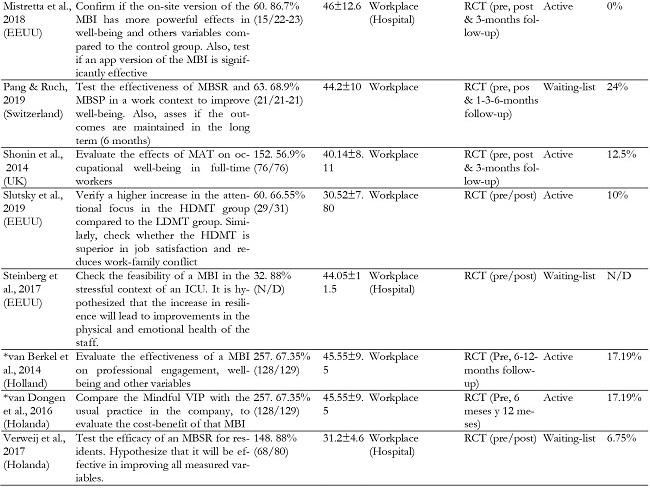
HDMT: High-dose Mindfulness Training; MBI: Mindfulness-based Intervention; LDMT: Low-dose Mindfulness Training; MAT: Meditation Awareness Program; MIM: Mindfulness in Motion; RCT: Randomized Controlled Trial; SRP: Stress Relapse Program; MBSP: Mindfulness-based Strengths Practice; MBSR: Mindfulness-based Stress Reduction; N/D: Data not known; ICU: Intensive Care Unit.
*These articles analyze different aspects of the same study.
Overall risk of bias of the studies included in the review
The results of the risk of bias assessment are presented in Table 2. 62.5 % of the studies presented a low risk in the generation of the random sequence and only 12.5 % had clearly concealed the allocation, minimizing the risk of bias in this domain. Risk of blinding of study personnel and participants was rated as low in 31.25 % of studies, while all studies were judged to be at low risk of bias for blinding of outcome assessors. Regarding the risk in the incomplete outcome data, 62.5% presented a low risk. 81.25 % of the studies were assessed as low risk in the domain of selective reporting of outcomes. Finally, 81.25 % of the studies were considered to have additional shortcomings that made the risk of bias high, such as using small and predominantly female samples, inactive controls, etc.
Sample description
Altogether, the total sample size of participants in the reviewed studies was 1590, with a mean age of 38.92 years. In all the studies, samples of both sexes were used, although the mean percentage of women was 74.71 %.
Design of the studies included in the review
Four studies (25 %) compared a MBI with an active control and the rest compared it with a waiting-list control. On the other hand, ten trials (62.5 %) developed follow-up assessments, while six only performed baseline and post-intervention measures.
Dropout rate
The general dropout rate was 23.74 %, although one of the studies did not report this data (Steinberg et al., 2017).
Characteristics of the MBIs used in the studies
Details of the MBIs can be found in Table 3. The practices developed consisted of focused attention meditations (e.g. attention to breathing, body scan, raisin exercise, mindful walking, etc.), in 100 % of the studies, and generative meditations (i.e. loving kindness, compassion, self-compassion) in 43.75 %. Formal and informal meditations were also included. Regarding the duration of the trainings, six of them (37.5 %) followed the standard of 8-weeks, one (6.25 %) included an additional ninth session of silent retreat, one (6.25 %) reduced the duration to seven weeks, three (18.75 %) used six weeks, the duration of one of them (6.25 %) was reduced to 3 weeks, another two (12.5 %) were done intensively over 4 and 6.5 weeks. Finally, two trainings (12.5 %) lasted for six months. The recommendations for daily practice were 10-20 minutes (50 %), 30 minutes (12.50 %), 20-40 minutes (6.25 %), 30-45 minutes (18.75 %). 12.50 % of studies did not specify a minimum practice time. Regarding the training method of the MBIs, eleven studies (68.75 %) used on-site training facilitated by an instructor, three (18.75 %) were carried out with an online application and two (12.5 %) used a mobile app.
Table 3 (cont): Characteristics of mindfulness-based interventions.
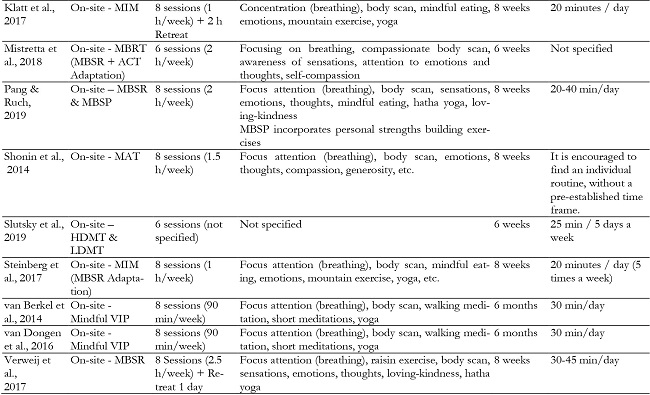
ACT: Acceptance and Commitment Therapy; HDMT: High-dose Mindfulness Training; LDMT: Low-dose Mindfulness Training; MAT: Meditation Aware-ness Program; MBCT: Mindfulness-based Cognitive Therapy; M-BIP: Mindfulness training program based on Brief Integrated Practices; MBRT: Mindful-ness.based Resilience Training; MBSP: Mindfulness-based Strengths Practice; MBSR: Mindfulness-based Stress Reduction; MSC: Mindful Self-Compassion; MIM: Mindfulness in Motion; SRP: Stress Relapse Program; WSM: Web-based Stress Management Program.
1For a description of the Headspace app, see: https://www.headspace.com/es/headspace-meditation-app
Psychological outcomes
Table 4 summarizes the main results found in the included studies.
Table 4: Main results of the studies included in the systematic review and their relation to the core dimensions of psychological well-being (Ryff, 2018).
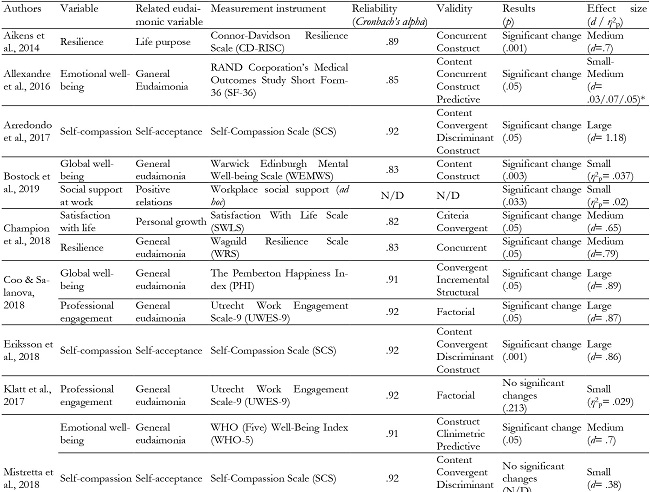
Table 4 (cont): Main results of the studies included in the systematic review and their relation to the core dimensions of psychological well-being (Ryff, 2018).
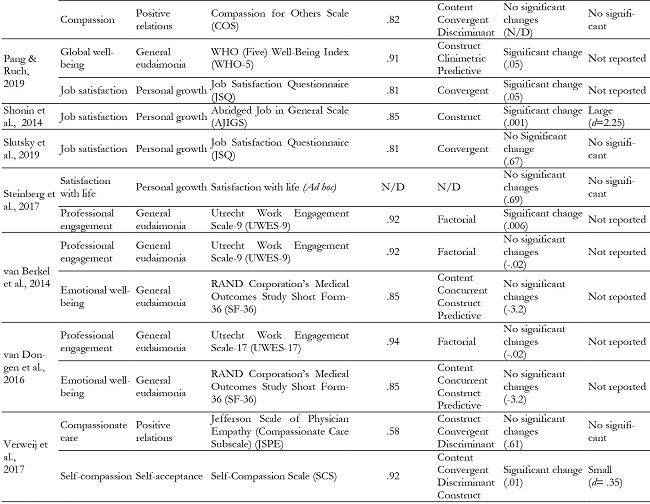
N/D: Data not known
*Effect sizes of conditions WSM/WSMg1/WSMg2 (WSM: Web-based Stress Management Program; WSMg1: WSM + support group; WSMg2: WSM + support group + expert clinical support).
General eudaimonia
Emotional well-being. On the relation between mindfulness and emotional well-being, results are contradictory in the studies included in our review. On the one hand, the mindfulness groups obtained improvements in comparison with the controls, and these were maintained over time, with medium and small effect sizes after periods of three months to one year follow up (Allexandre et al., 2016; Mistretta et al., 2018). However, other studies found no statistically significant difference between the intervention and control group after 6- and 12-month follow-up (van Berkel et al., 2014; van Dongen et al., 2016).
Global well-being. Three studies have evaluated well-being from an integrative approach, that is, unifying hedonia and eudaimonia, obtaining significant improvements in all cases, although with different effect sizes. Specifically, the effect size was small in the study by Bostock et al. (2019), while it was large in Coo & Salanova (2018). Although Pang & Ruch (2019) did not report effect size data, they did follow-up after one, three and six months, finding that the improvements were maintained over time, while the level of significance decreased.
Work Engagement. Engagement was evaluated in five of the studies included in our review, although only two studies found improvements in this variable (Coo & Salanova, 2018; Steinberg et al., 2017). Of these, only Coo & Salanova (2018) reported the effect size (large, in this case). In one trial, MBI was not significantly effective in improving engagement compared to control (Klatt et al., 2017). Finally, two studies found that, even if not significantly, engagement tended to decrease (van Berkel et al., 2014; van Dongen et al., 2016), and these results may be due to the low intensity and duration of the interventions.
Self-acceptance
Self-compassion. The results concerning self-compassion are consistent in three of the studies (Arredondo et al., 2017; Eriksson et al., 2018; Verweij et al., 2017), having confirmed that the MBIs were effective in increasing it in the workplace. However, Mistretta et al. (2018) found no significant changes. Effect sizes range from small (Verweij et al., 2017) to large (Arredondo et al., 2017; Eriksson et al., 2018). Additionally, Arredondo et al. (2017) found that benefits remained stable at five months follow up.
Positive relations
Compassion. Regarding this construct, Mistretta et al. (2018) found that a combination of Mindfulness-based Stress Reduction (MBSR) and Acceptance and Commitment Therapy (ACT) was not effective in producing significant changes in participants' compassion scores. The study conducted by Verweij et al. (2017) also found no evidence of change when comparing MBSR to an inactive control.
Social support at work. Of the 16 included trials, only one (Bostock et al., 2019) analyzed the effects of an app-guided MBI on social support at work. In this sense, it was found that mindfulness and loving-kindness training improved daily relationships between peers, significantly increasing social support compared to an inactive control group. The effect size was small when comparing post-intervention improvements and scores at four months follow up. It is important to note that the instrument used to measure social support at work was made ad hoc, lacking reliability and validity.
Personal growth
Satisfaction with life. This variable was evaluated in two of the studies reviewed. Thus, Champion et al. (2018) reported that mindfulness meditation produced significant improvements over an inactive control, with a small effect size at the end of the study. In contrast, Steinberg et al. (2017) found no significant differences, although the instrument used lacked reliability and validity.
Job satisfaction. This type of satisfaction was evaluated in three studies. In two of these, statistically significant changes were found, both compared to a waiting-list control (Pang & Ruch, 2019) and to an active control (Shonin et al., 2014). In both cases, the improvements were maintained over time, although with a downward trend. On the other hand, Slutsky et al. (2019) found that job satisfaction increased marginally, although significantly, in a group with a high dose of meditative practice compared to a low intensity group. Regarding the effect size, in this case it was not significant.
Purpose in Life
Resilience. Two trials have reported significant improvements in resilience, with medium effect sizes, when training mindfulness through an online platform (Aikens et al., 2014) or through an app (Champion et al., 2018). In both cases, the experimental groups were compared with a waiting-list control condition. In turn, in one of the studies, the improvements remained stable at six months follow-up (Aikens et al., 2014).
Discussion
This systematic review provides a first approach to the eudaimonic benefits obtained by using different MBIs in the workplace. In light of the studies analyzed, it can be considered that mindfulness could be useful to significantly and moderately improve the general state of psychological well-being, as well as self-compassion, social support at work, job satisfaction and resilience. This conclusion is based on the consistency of the results that have been found in the included trials related to these variables. Also, it is based on the validity of all the instruments used, as well as its excellent general reliability, with Cronbach's alpha values between 0.81 and 0.94. An exception is found in "social support at work", a variable that was measured in a single study and with an instrument that was not validated, so this result should be considered with reservations. Additionally, it is possible that the inconsistency of the results in other variables is due to the use of non-validated and/or unreliable instruments, as in the case of compassionate care.
In relation to the six dimensions of psychological well-being (Ryff, 2018), meditative practice seems to foster self-acceptance, positive relationships, and personal growth. These results only marginally replicate the findings of research conducted in other settings. For example, Iani et al. (2017) found that mindfulness moderately enhanced the core eudaimonic dimensions of the psychological well-being in the general population (i.e., autonomy, purpose, and personal growth). On her side, Sun (2017) found that self-compassion practices were beneficial for improving autonomy, environmental mastery, positive relations, purpose in life, and personal growth in adolescents.
Regarding the rest of the variables evaluated in the studies included in our review, the results are controversial and, even when consistency has been found between positive findings of different studies, these should be taken with caution. This is because, in general, the studies evaluated have important shortcomings, such as the use of inactive controls, small samples sizes and mainly composed of women, risk of bias derived from the high motivation of the subjects to learn meditative techniques, results that can only be generalized to the professional groups that received the training, etc. These problems are similar to those noted in previous works (Conrado-Montoya et al., 2016; Hedman-Lagerlöf et al., 2018).
Furthermore, the training protocols included in this study are, in general, belonging to the first generation of MBIs. This means that its contents are not specifically focused on the cultivation of eudaimonic well-being, which makes the limited scope of the improvements understandable. Perhaps the new MBIs will produce larger and deeper increases in psychological well-being. However, a recent pilot study (Carmona-Rincón, 2021) showed that a specific training in ethical awareness and wisdom, for 41 weeks, did not produce significant effects on the levels of eudaimonia in a non-clinical sample, despite the fact that, among other positive outcomes, there were significant changes in mindfulness, compassion and non-duality. This opens the question of whether the fruit of trainings in ethics and wisdom corresponds to what the eudaimonia tests measure or these trainings are irrelevant for the eudaimonic well-being.
Leaving aside any methodological problem that can be found, which should be corrected in future research, the lack of positive results in some studies may be due to the reduction in intensity and duration of the practice. Meditation is a training designed to generate a long-term change in the way people understand and relate to reality. Such deep behavior modification cannot occur in just two months of training, requiring committed practice for months or even years to consolidate (Gordon & Shonin, 2020). Therefore, it is not consistent to expect significant and stable improvements by reducing, more and more, the time dedicated to the practice. In fact, the tendency to improve the impact of the MBIs has been to prolong the duration of the training, for example starting with the MBSR and then a 8-weeks program that cover its gaps in cultivating virtue (Cebolla & Alvear, 2019), or even designing programs lasting up to three years with different levels of training (Segovia, 2017).
The reality is that mindfulness meditation is under pressure to adapt to a socioeconomic model characterized by the search for immediate results. This, as Joiner (2017) criticizes, distorts its practice and reduces it to a fashionable product (spiritual materialism) whose benefits are, consequently, limited. Thus, taking into account the nature of meditation and its general empirical results, it is worth asking whether the corporate use of MBIs is efficient and pertinent, based on the availability of time for instruction and practice, or if, in any case, mindfulness should be used as an additional resource to other techniques whose effectiveness is well established.
This systematic review has some limitations, such as the lack of a meta-analysis due to the heterogeneity of the interventions used and the results obtained. Also, it should be considered that the methodological shortcomings of the included studies limit the scope of the conclusions, as well as their extrapolation to the organizational context in general. However, this review provides clarity about the eudaimonic potential of MBIs in corporations, contributing to the literature on the benefits of mindfulness on psychological well-being, and reorienting its analysis to the soteriological context.
Future research should use more robust designs, as well as instruments that allow obtaining specifically eudaimonic measures. Focusing on the organizational context, an interesting line of research would be to investigate whether there is a relation between trait-mindfulness and eudaimonic well-being at work (Bartels et al., 2019). This reconceptualization of the psychological well-being (Ryff, 2018) defines eudaimonia at work as the perception that a person has about her ability to develop and function optimally in her workplace. According to the evidence, this construct is independent of general eudaimonia and is closely related to the sense of meaning and purpose at work, the experience of positive social interactions, job satisfaction, organizational citizenship behaviors and the popularity of employees (Bartels et al., 2019). Having a better understanding of the possible relation between mindfulness and this eudaimonic-like well-being would make it possible to design MBIs (with first- or second-generation approaches) especially adapted to the needs of the organizations.
Similarly, we consider it is necessary for science to reach a consensus on the definition of mindfulness, which is understood both as conscious attention or concentration and as a vigilant meta-attention that allows us to realize distraction (Segovia, 2017, 2018, 2019). This would make it possible to draw more solid conclusions. Also, it would be appropriate to use standardized guidelines for all meditation exercises, with specific instructions, which enable their uniform use. A work in this line can be found on Isbel & Summers (2017).
Finally, the variety of meditative exercises used in the MBIs makes it difficult to reach consistent conclusions about how each of them affects the dimensions of psychological well-being. For example, it would be interesting to know which specific exercises and facets of mindfulness are responsible for the possible changes. To do this, some lines of research could deconstruct training to understand its active components, allowing it to be debugged if necessary. It would allow, in attention to the warning of Coronado-Montoya et al. (2016), that replication studies provide consistency to the positive outcomes reported and also would allow us to ascertain to what extent they could be oversized.











 texto em
texto em 

